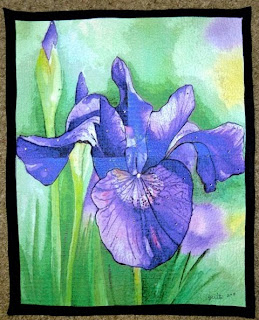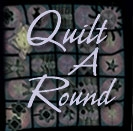
Meet Zerita. She is a member of the California Association of Machine Embroiderers (CAME). She was in my Altered Photo Artistry workshop at their annual seminar in 2010. It was a delightful surprise to see her in the same workshop earlier this month. Little did I know, she has become a Threadography® GODDESS!
This time she worked on a cluster of beautiful California poppies. She was too modest to tell me this wasn't her second, or even third, Altered Photo Artistry piece (Threadography). Our mutual friend Rhoda spoke up to inform me Zerita had made 15 in the last year!!!
"These are my passion!" she says enthusiastically. Zerita’s husband enjoys working with Photoshop Elements, so they are collaborative efforts. This is a photo of one wall in their home theater with a display of Threadographies.
A shot of another wall shows they have room for a few more pieces!
I didn’t ask her what this flower is. We saw it in a garden, blooming on an unfamiliar (to me) succulent. The stamen and pistils really “pop” because Zerita painstakingly outlined each of the floral elements.
Purple-and-white iris are a particular favorite of mine and this one really complimented the rainbow of pink, yellow, orange, and blue blossoms in the groupings.
Orange day lily is a good choice for a quilter working on a first-time Threadograph.
Zerita’s 16th piece is a kaleidoscope stitched for a friend—and highlighted with hot-fix crystal rhinestones.
Dahlias are dramatic and beautiful, but I recommend them for a second or third project, because they require so much outlining.
Zerita has done an outstanding job of enhancing the illusion of depth by outlining the flower and not the leaves.
Roses are a favorite subject for altered photos. The curling petals offer plenty of variety in highlights and shadows.
Hollyhocks with single petals are fun to stitch, but the intricacies of double or ruffled petals add a richness to the composition.
I'm tempted to say these look like snapdragons, but I'm not positive. Their petals are similar shaped—and they have spotted details deep in the blossoms’ throats.
Oriental poppies with their textured centers offer a stitching challenge, but the finished piece is well worth the effort!



 Zerita's husband made the mock-up of a magazine cover as a surprise. Maybe I'll have to add this as a project in my new online Photoshop Elements class!
Zerita's husband made the mock-up of a magazine cover as a surprise. Maybe I'll have to add this as a project in my new online Photoshop Elements class!




























6 comments:
These are wonderful! I'm glad you posted all the photos, what a treat. As a Northern Californian these are all familiar to me, and it's marvelous to see them as quilts.
these are fascinating.
giving flower names is probably not the purpose of your posts, but
could you tell me what the blue flower is called which is 2 down from the hibiscus?
I used to live in Ohio,in America where I saw these all the time at the side of the road(and when we took a road trip out west), but I never knew what they were called. I gave up trying to get people to understand what I was trying to describe.
and now that I live in England, there is definitely no hope of finding out by description only!
Sandy in the UK
It is hard to believe these are not photos. These pieces are ready for art shows! Congratulations on your teaching abilities.
Beth, The flower about which you didn't have a name is a protea and it's commonly referred to as "sugarbush." FYI
How fun to find out what an impact you have as a teacher. Zerita did a wonderful job and the magazine mock up is a fun touch:)
This work is amazing. We call that protea a waratah in australia and the blue flower is chicory. Does zarita have a website or blog?
Post a Comment